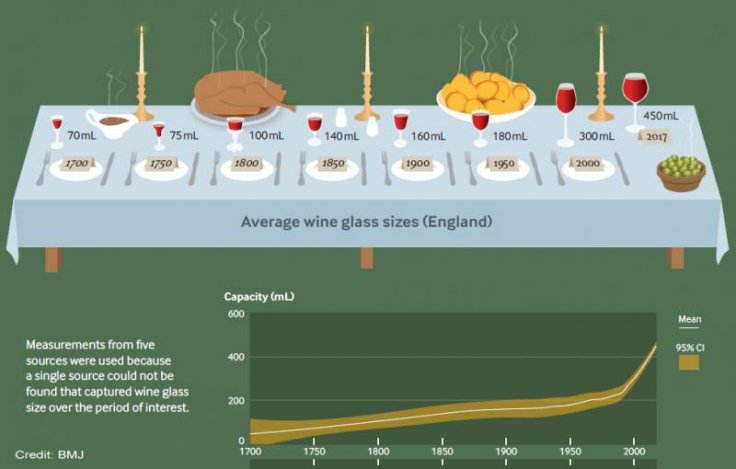
The wine glass used during the British Georgian and Victorian Christmas celebrations about 300 years ago grew phenomenally by seven times the original size, said researchers from the University of Cambridge.
With the help of experts in antique glassware, museum curators, the researchers obtained measurements of 411 glasses from the year 1700 to 2017. They found that wine glass capacity increased from 66 ml in the 1700s to 417ml in the 2000s, with the mean wine glass size in 2016-17 being 449ml.
They found an almost four-fold increase in the size of the wine glass between 1960 and 1980, and it doubled between 1980 and 2004. Until the latter part of the 20th century, beer and spirits were common alcohol while wine was confined to the upper classes.
"Wine will no doubt be a feature of some merry Christmas nights, but when it comes to how much we drink, wine glass size probably does matter," says Professor Theresa Marteau, Director of the Behaviour and Health Research Unit at the University of Cambridge.
Professor Marteau and his colleagues wanted to understand whether any changes in their size might have contributed to the steep rise in alcohol consumption over the past few decades. They experimented further at the Pint Shop in Cambridge, downsizing wine glasses but keeping the serving size the same. They were surprised to find that there was almost 10% increase in sales.
Wine glasses became common around 1700. Later, lead crystal glassware was developed by George Ravenscroft in the late 17th century, which led to less fragile and larger glasses, which in turn increased the capacity of wine as well in England significantly over the past 300 years, explained first author Zorana Zupan.
"For the most part, this was gradual, but since the 1990s, the size has increased rapidly. Whether this led to the rise in wine consumption in England, we can't say for certain, but a wine glass 300 years ago would only have held about a half of today's small measure. On top of this, we also have some evidence that suggests wine glass size itself influences consumption," he noted.
Increases in the size of wine glasses also reflect contemporary factors such as price, technology, societal wealth and wine appreciation. The 'Glass Excise' tax, levied in the mid-18th century, led to the manufacture of smaller glasses and its abolition in 1845 again widened the scope for larger glasses. Even in terms of technology, from the traditional mouth-blowing technique, manufacture of glass shifted to more automated process since the late Victorian era.
Two changes in the 20th century -- shape and size for different wine varieties -- contributed to a burgeoning market for wine appreciation, requiring the need for larger glasses, said the study. From 1990 onwards, demand for larger wine glasses by the US market was met by an increase in the size of glasses manufactured in England.
Another factor was an increase in consumption of wine in bars and restaurants, where the sales of wine increased when sold in larger glasses. Larger wine glasses can also increase the pleasure from drinking wine, and boost the desire to drink more, explained the researchers.
Finally, the researchers said there will be some resistance to their findings but wine palatability will be greater in the month of January than that of December.
The study was published in The BMJ.








